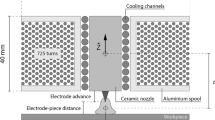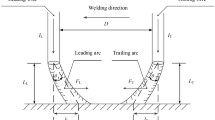Abstract
Arc-based welding processes are susceptible to the magnetic field effects. The electric arc shape, the current density, and the welding energy can influence the weld pool and weld properties, providing an additional degree of freedom for process control. This study analyzed the electromagnetic effect in constriction and expansion on arc shape changing and also the consequence on the weld bead geometry. The results demonstrated that with the electromagnetic field action, the electric arc cross-section was changed from cylindrical to elliptical, and that the greater the coils’ excitation, the greater the effect. It was also observed that with the coil excitation current inversion, the ellipse orientation rotates 90° and that the greater the arc constriction (transversally to weld), the greater the penetration and the shorter the bead width. Furthermore, the greater the electric arc expansion (transversally to weld), the lower the penetration and the greater the bead width. The ellipse is rotated electrically without the need for mechanical movement or reassembly, which makes it easy and agile to rotate the ellipse. The coils are electrically powered which allows a continuous range of excitation current (0 to 10 A) and consequently of forces acting on the change in the electric arc shape. With the coil excitation current increase, there is an electric arc area reduction and, therefore, a current density and heat intensity increase. The use of this device allows an additional independent parameter in arc welding processes and allows different weld bead geometries for the same welding current.
Highlights
-
The electromagnetic constriction and expansion change the cross-section of the electric arc from cylindrical to elliptical, and the inversion of the coil excitation current provides a 90° rotation of this ellipse.
-
The geometric changes of the arc are reflected in the geometry of the bead, that is, the greater the constriction of the arc, the greater the penetration and the smaller the width of the bead. In the same way, the greater the expansion of the electric arc, the smaller the penetration and the greater the width of the bead.
-
The reduction in the area of the electric arc is proportional to the increase in the coil excitation current. This reduction in arc area causes an increase in heat intensity and current density.
















Similar content being viewed by others
Data availability
The datasets supporting the results of this paper are included within the paper.
References
Biradar N, Raman R (2012) Grain refinement in Al-Mg-Si alloy TIG welds using transverse mechanical arc oscillation. J Mater Eng Perform 21(11):2495–2502
Li Y, Wu C, Wang L, Gao J (2016) Analysis of additional electromagnetic force for mitigating the humping bead in high-speed gas metal arc welding. J Mater Process Technol 229:207–215
Luo J, Luo Q, Wang X, Wang X (2010) EMS-CO2 welding: a new approach to improve droplet transfer characteristics and welding formation. Mater Manuf Processes 25(11):1233–1241
Chang YL, Liu XL, Lu L, Babkin A, Lee BY, Gao F (2014) Impacts of external longitudinal magnetic field on arc plasma and droplet during short-circuit GMAW. Int J Adv Manuf Technol 70(9–12):1543–1553
Liu Y, Sun Q, Wang H, Zhang H, Cai S, Feng J (2016) Effect of the axial external magnetic field on copper/aluminium arc weld joining. Sci Technol Weld Joining 21(6):460–465
Jian X, Wu H (2020) Influence of the longitudinal magnetic field on the formation of the bead in narrow gap gas tungsten arc welding. Metals 10(10):1351
Sun Q, Wang J, Cai C, Li Q, Feng J (2016) Optimization of magnetic arc oscillation system by using double magnetic pole to TIG narrow gap welding. Int J Adv Manuf Technol 86(1):761–767
Liu Z, Chen S, Yuan X, Zuo A, Zhang T, Luo Z (2018) Magnetic-enhanced keyhole TIG welding process. Int J Adv Manuf Technol 99(1):275–285
Wu H, Chang Y, Babkin A, Lee B (2021) The behavior of TIG welding arc in a high-frequency axial magnetic field. Weld World 65(1):95–104
Baskoro AS, Fauzian A, Basalamah H, Kiswanto G, Winarto W (2018) Improving weld penetration by employing of magnetic poles’ configurations to an autogenous tungsten inert gas (TIG) welding. Int J Adv Manuf Technol 99(5):1603–1613
Sun Q, Li J, Liu Y, Jiang Y, Kang K, Feng J (2018) Arc characteristics and droplet transfer process in CMT welding with a magnetic field. J Manuf Process 32:48–56
Liu Y et al (2019) Optimization of magnetic oscillation system and microstructural characteristics in arc welding of Al/Mg alloys. J Manuf Process 39:69–78
Corradi DR, Bracarense AQ, Wu B, Cuiuri D, Pan Z, Li H (2020) Effect of magnetic arc oscillation on the geometry of single-pass multi-layer walls and the process stability in wire and arc additive manufacturing. J Mat Proc Technol 283:116723
Liu S, Liu ZM, Zhao XC, Fan XG (2020) Influence of cusp magnetic field configuration on K-TIG welding arc penetration behavior. J Manuf Process 53:229–237
Nomura K, Morisaki K, Hirata Y (2009) Magnetic control of arc plasma and its modelling. Weld World 53(7–8):R181–R187
Wu H, Chang Y, Lu L, Bai J (2017) Review on magnetically controlled arc welding process. Int J Adv Manuf Technol 91(9–12):4263–4273
Nomura K, Ogino Y, Hirata Y (2012) Shape control of TIG arc plasma by cusp-type magnetic field with permanent magnet. Weld Int 26(10):759–764
Antonello MG, Bracarense AQ (2020) Device design for electric arc electromagnetic constriction. Soldagem & Inspeção 25:e2539
Wu H, Chang Y, Guan Z, Babkin A, Lee B (2021) Arc shape and microstructural analysis of TIG welding with an alternating cusp-shaped magnetic field. J Mat Proc Technol 289:116912
Tseng K-H, Chen K-L (2012) Comparisons between TiO2-and SiO2-flux assisted TIG welding processes. J Nanosci Nanotechnol 12(8):6359–6367
Howse D, Lucas W (2000) Investigation into arc constriction by active fluxes for tungsten inert gas welding. Sci Technol Weld Joining 5(3):189–193
Olivares EAG, Silva RHG, Dutra JC (2015) Estudo da Técnica Tig Keyhole por Meio do Análise Comparativo entre Duas Tochas de Alta Produtividade na União de Chapas de Aço Carbono de Meia Espessura. Soldagem & Inspeção 20(3):262–274
González Olivares EA, Gonçalves e Silva RH, Dutra JC (2017) Study of keyhole TIG welding by comparative analysis of two high-productivity torches for joining medium-thickness carbon steel plates. Weld Int 31 (5) 337–347
Balram Y, Rajyalakshmi G (2019) Thermal fields and residual stresses analysis in TIG weldments of SS 316 and Monel 400 by numerical simulation and experimentation. Mat Res Exp 6 (8) 0865e2
Lu F, Yao S, Lou S, Li Y (2004) Modeling and finite element analysis on GTAW arc and weld pool. Comput Mat Sci 29(3):371–378
Vasudevan M, Chandrasekhar N, Maduraimuthu V, Bhaduri A, Raj B (2011) Real-time monitoring of weld pool during GTAW using infra-red thermography and analysis of infra-red thermal images. Weld World 55(7):83–89
Qi B, Yang M, Cong B, Liu F (2013) The effect of arc behavior on weld geometry by high-frequency pulse GTAW process with 0Cr18Ni9Ti stainless steel. Int J Adv Manuf Technol 66(9–12):1545–1553
Yang M, Qi B, Cong B, Liu F, Yang Z, Chu PK (2013) Study on electromagnetic force in arc plasma with UHFP-GTAW of Ti-6Al-4V. IEEE Trans Plasma Sci 41(9):2561–2568
Acknowledgements
Thanks to the Industrial Technical College and to the federal universities of Santa Maria, Minas Gerais, and Santa Catarina for their assistance and partnership.
Author information
Authors and Affiliations
Contributions
Miguel Guilherme Antonello: conceptualization, methodology, validation, formal analysis, investigation, writing—original draft, visualization. Alexandre Queiroz Bracarense: conceptualization, writing—review and editing. Ivan Olszanski Pigozzo: formal analysis, resources. Marcelo Pompermaier Okuyama: formal analysis, resources. Régis Henrique Gonçalves e Silva: resources, writing—review and editing.
Corresponding author
Ethics declarations
Ethics approval
Not applicable.
Consent to participate
Not applicable.
Consent for publication
The authors do agree that the copyright of this paper is transferred to Springer’s journal “The International Journal of Advanced Manufacturing Technology” when the paper is accepted for publication.
Conflict of interest
The authors declare no competing interests.
Additional information
Publisher's note
Springer Nature remains neutral with regard to jurisdictional claims in published maps and institutional affiliations.
Supplementary Information
Below is the link to the electronic supplementary material.
Supplementary file1 (MP4 39322 KB)
Supplementary file2 (MP4 39390 KB)
Rights and permissions
About this article
Cite this article
Antonello, M.G., Bracarense, A.Q., Silva, R.H.G.e. et al. Electric arc shape and weld bead geometry analysis under the electromagnetic constriction and expansion effect. Int J Adv Manuf Technol 118, 1689–1701 (2022). https://doi.org/10.1007/s00170-021-08064-5
Received:
Accepted:
Published:
Issue Date:
DOI: https://doi.org/10.1007/s00170-021-08064-5




